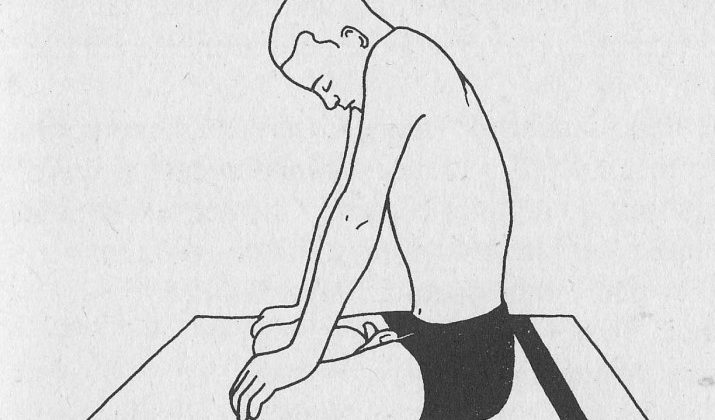
Jaalandhar Bandh
Ayurveda says that there are 10 different types of the air element in the body – five Pradhaana Vaayu (primary airs), namely, Praana Vaayu, Apaana Vaayu, Udaana Vaayu, Samaana Vaayu and Vyaana Vaayu. And five Upa Vaayu (secondary airs), namely, Naaga Vaayu, Kurma Vaayu, Devadatta Vaayu, Krikalaa Vaayu and Dhananjaya Vaayu.
Each Vaayu is located in a particular part of the body and facilitates functioning of the organs/systems in the region where it is located.
Udaana Vaayu is located mainly in and around the throat region. It flows upwards from the heart region and governs the functioning of the organs, glands and the chakras (energy centres) situated in the throat and above the throat (skull/head) region.
When the flow/circulation of Udaana Vaayu is regular/consistent, it helps to maintain the health of the vocal cord, sinus, eyes, ears, nasal passage, brain, etc.
According to the philosophy of Ayurveda & Yoga, Vishudha chakra is in the throat region – when it is functioning well and the energy flow to & around this chakra is consistent, it gives good communication skills and enhanced ability to convince/influence others. When this chakra is not healthy and the energy flow around this chakra is disturbed, then our ability to express/communicate is adversely affected.
In my Ayurvedic practice, I have come across many young children who are studying in schools and universities who have a common problem – they don’t do so well in their exams, be it written exams or oral exams, in spite of knowing the answers in the back of their minds. It becomes difficult for them to express what they learned in preparing for the exams.
Ayurveda explains that this kind of situation & symptoms is caused due to the poor flow/circulation of Udaana Vaayu. Once this is corrected and the Udaana Vaayu is brought back into balance, then this problem can be resolved.
One of the easiest and fastest methods to resolve this problem is “Jaalandhar Bandh” (chin/throat lock).
This is one of the three Yogic “Bandh” (locks). The other two locks are called “Mula Bandh” (the basal lock) and “Uddyan Bandh” (abdominal lock).
In Jaalandhar Bandh, the neck is bent forward to the fullest extent so that the chin touches the cavity of the throat, sternum, between the ends of the two collar bones.
How does one apply the chin lock?
Posture: Sit in a comfortable meditative pose, e.g. Padmaasana (Lotus Pose), Sukhaasana (Easy Pose), Vajraasana (Thunderbolt Pose), etc.
Technique/Method 1:
- Breathe in and out at a normal pace.
- Inhale slowly and fill the lungs up with air/oxygen.
- Hold the breath for 6 – 10 counts by bending the neck forward and pressing the chin between the two collar bones into the cavity of the throat. The pressure should be such that it can block the wind pipe so that the breath can be held within comfortably without releasing any air.
- Then raise the chin straightening the neck to the normal straight position.
- Exhale slowly.
- Repeat steps 2 – 5 above 5 times to start with, and gradually increase to 10 times per day.
This technique is called “Jaalandhar Bandh”.
Yoga always emphasizes the complementary exercises/postures which support and enhance the beneficial effects of the primary/main exercises/postures. Sometimes, if the complementary exercises/postures are not done then this can make the primary/main exercise/posture incomplete. As a result, one does not feel/experience the optimum benefit of doing Yoga; on the contrary, sometimes when complementary exercises/postures are not done, one may feel/experience adverse effects of doing yoga exercises/postures.
Therefore, it is recommended to do the complementary exercise of the “Jaalandhar Bandh” as well, which is as follows:
Posture: Sit in a comfortable meditative pose, e.g. Padmaasana (Lotus Pose), Sukhaasana (Easy Pose), Vajraasana (Thunderbolt Pose), etc.
Technique/Method 2:
- Breathe in and out at a normal pace.
- Breathe in deeply and simultaneously start bending the neck backward as far it can go, without causing any discomfort.
- Hold the breath for 6 – 10 counts.
- Straighten the neck to the normal position while exhaling at the same time.
- Repeat steps 2 to 4 above 5 times, to begin with, increasing it to 10 times for daily practice.
Ideally, technique 1 & technique 2 should be done one after the other to maximize the effects of the “Jaalandhar bandh”.
Regarding the benefits of “Jaalandhar Bandh”, in one of the Yogic texts it is said:
“Jaalandharey Kritey bandhey, kantha sankocha lakshaney;
Na piyusham pataty agnau, na cha vaayuh pradhaavati.
Translation: Applying Jaalandhar Bandh (the chin lock – by pressing the chin in between the two collar bones) which contracts (and presses) the cavity of the throat, helps to stop the dripping of the nectar which is produced in the “sahasraar chakra” (crown chakra/thousand petal lotus centre) by blocking the passage in the throat region, thus preventing it from getting burnt in the digestive system. And by controlling the life force, it facilitates (increases the chances of) the awakening of the “Kundalini Shakti” (dormant power which is coiled below/near the root chakra).
There are various methods described in Yoga to help prevent the dripping of this nectar from the sahasraar chakra and burning in the digestive system – we will discuss these in future blogs. Also, there are various techniques given in Yoga for awakening one’s Kundalini power – we will also discuss these in future articles.
To book an online appointment at Ayuryoga, with our Ayurveda/Yoga Expert Mr. Vinod Sharma Hong Kong please click here.








